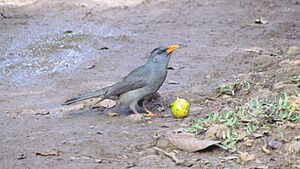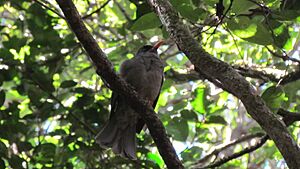Mauritius bulbul facts for kids
Quick facts for kids Mauritius bulbul |
|
|---|---|
 |
|
| Conservation status | |
| Scientific classification | |
| Synonyms | |
|
The Mauritius bulbul (Hypsipetes olivaceus) is a special type of songbird. It belongs to the bulbul family, which is a group of birds known for their lovely songs. This bird lives only on the island of Mauritius, which is why it's called "endemic" to that place.
Contents
About the Mauritius Bulbul
Scientists give every animal a special name, like Hypsipetes olivaceus for the Mauritius bulbul. This helps them keep track of all living things. In the past, some scientists thought this bulbul belonged to a different group of birds. It was even considered a type of Réunion bulbul for a while. Other names for this bird include the Mauritius black bulbul and the Mauritius merle.
What the Mauritius Bulbul Looks Like
The Mauritius bulbul can grow to be about 24 centimeters (9.4 inches) long. It has bright yellow-brown eyes that stand out. Its legs are pink, and its beak can be orange or yellow. The feathers on its body are mostly grayish. It also has a cool black crest on its head. Young Mauritius bulbuls look a bit different. Their feathers are pale brown, and their beaks are blackish.
Life and Habits of the Bulbul
Reproduction and Life Cycle
During the warm southern summer, the female Mauritius bulbul lays two eggs. These eggs are a pretty pinkish color. She builds her nest using straw and small roots. The eggs stay in the nest for about 14 to 16 days before they hatch.
What the Bulbul Eats
The Mauritius bulbul enjoys a varied diet. It eats insects, different kinds of seeds, and tasty fruits. One of its favorite foods is the ripe berries from a plant called Spanish Flag.
Challenges and Conservation
Long ago, people sometimes ate Mauritius bulbuls on special days. Later, the biggest dangers to these birds changed. Their forest homes were cut down to make room for tea plantations. Also, invasive weeds, like the Spanish Flag plant, grew everywhere. The birds actually helped spread these weeds by eating their berries. Another big problem was predation by crab-eating macaques, which were brought to the island by humans.
In the mid-1970s, there were only about 200 pairs of Mauritius bulbuls left. Luckily, people worked to stop their numbers from dropping further. Today, the Mauritius bulbul is still rare, but its population is quite stable. In 1993, scientists counted about 280 pairs of these special birds.



